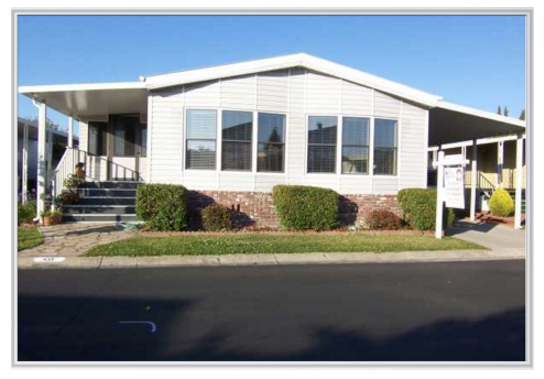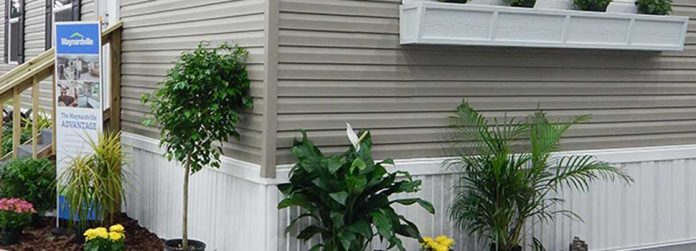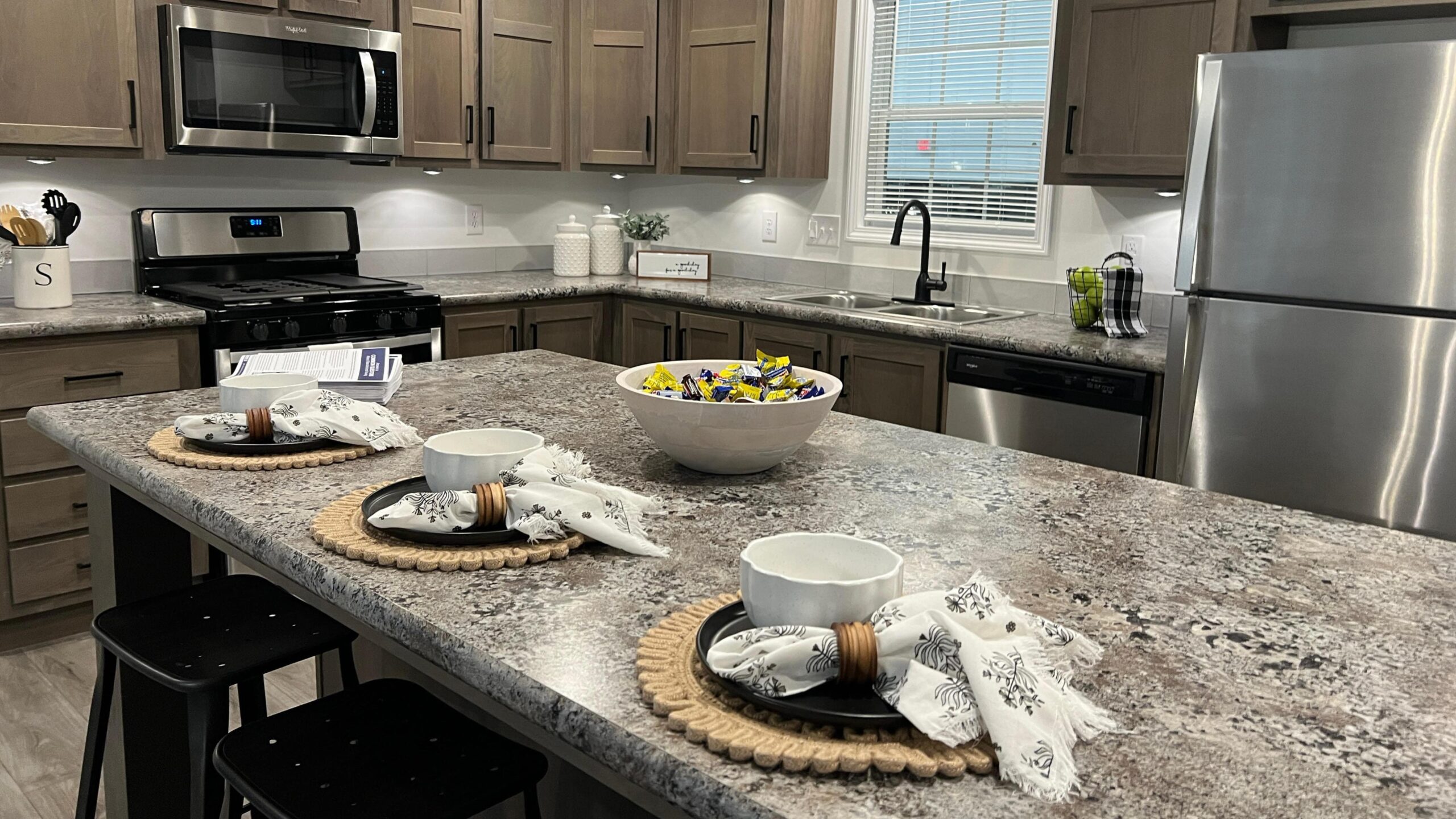Pick the Mobile Home Skirting Material that Suits You Best, and Watch Out for a Few Pitfalls
Mobile home skirting is required around the home’s bottom exterior to keep away pests and moisture. Additionally, the installation of skirting can enhance the visual appeal of the home by masking piers, tie-downs and the concrete slab.
Many online marketplaces and corner hardware stores sell mobile home skirting. However, the question remains, what feature set, what material and what look is best for you?
Standard vinyl skirting comes in 12-foot long panels. It’s cut to width for the average height off the ground from the bottom of the home. Vinyl is the least expensive option, and comes in solid panels or panels with vent holes.
Other Mobile Home Skirting Options
Chris Carpenter, manager of Southern Heritage Homes of Louisiana in Denham Springs, La., said vinyl remains the most common purchase for this product type.
“Another common material here is called K-ROK, which is panel that looks like stone or brick. You can get it in a great number of varieties, and it’s typically much more expensive than vinyl,” Carpenter said. “I tell my customers to go with the vinyl material. It’s cheaper, it ventilates your home better, and it’s easy to replace. And vinyl comes in about four or five different colors.”

The cost of K-ROK skirting is about four times that of the vinyl product, which costs about $500 for enough sheeting to enclose a 16-foot by 84-foot single-section home.
Kurt Taubert, co-owner of Mobile Home Depot in Highland, Mich., said he sells nearly as much aluminum skirting as he does vinyl. Faux brick and stone, as well as textured varieties, make up about 20 percent of his mobile home skirting sales.
Regional Considerations
“Those two are the standard,” Taubert said of vinyl and aluminum “We have Rapid Wall, which is a flat pebbled finish and a higher-priced product. We also have Exteria, which is a faux brick, and is a thicker panel than K-ROK. We offer R-Cotec, which is a steel panel with foam for insulation and a painted brick texture.

“That’s very popular in the northern states because it’s insulated,” he said of R-Cotec.
Transition zones such as the upper central plains require homeowner to weigh the winter benefits of insulated mobile home skirting. That same winter protection can create a summer home for termites and other pests.
“Termites will tunnel through from the bottom,” Taubert said. “They’re very hard to detect until it’s a real problem.”
Steel is trending
Larry Harmon, manager of Tulsa Siding Pro in Tulsa, Okla., has a product that has become a company of its own. With Strong Skirt, a bit more than six years in, he feels he’s met the original intent of offering mobile home skirting that is durable and FHA compliant, covers most cities’ ordinances, and is of value to the customer.
“Strong Skirt is an all steel product,” Harmon said. “It’s the most weed eater resistant. You don’t have to worry about getting your grill too close to it. And the 17 color choices really allow the homeowner to get the look they want.
Maintenance
“The installation tasks with Strong Skirt are about the same as vinyl,” Harmon said. “The cost is about double what you’ll pay for vinyl. Likewise, it takes about twice as long to install. But it’s much more durable and stays looking the way you want it to look.”
Typically, Taubert talks to his customers about maintenance and longevity when considering material types.
“Aluminum will dent if a ball is kicked into it, but it will hold up to a weed wacker,” he said. “The vinyl will get eaten up by the weeder, but it will flex and bounce back if a ball is kicked into it.”
Skirting of nearly any variety can sustain damage or be destroyed by a weeder. This will be unsightly and provide access for water to enter. Additionally, these compromises in the mobile home skirting provide an animal gateway to chew on wiring and harm other utilities. Worse yet, they could take up residence under your home.
So, there are three primary approaches to beating back skirting damage caused by weeding.
First, consider putting down a few inches of plastic and landscaping stone around the skirting. Second, you can spray chemical weed killer, which tends to yellow the surrounding foliage. As a result, the remaining spray could be toxic for pets and children. The third option is a bit of a manufactured home maintenance hack…
Mobile Home Skirting Installation Tips
“You can order an extra length of that thick vinyl tracking typically used on the top of the skirting,” Carpenter said. “You use that same product on the bottom and it will help keep the vinyl panel protected when you’re working in your yard.”
Additionally, Carpenter reminds customers to use a concrete bit with a drill for the hole and anchor spots in a concrete slab. The alternative, liquid nail products, will deteriorate easily and allow the wind or animals to pull up the skirting.
“With the top of the skirting, it’s a good idea to screw a couple of the panels in and pull them tight,” Carpenter added. “Then you get the other panels placed and screw them to the home about every four to five feet. This keeps the skirting secure on the top.”
The following tools will be required to install your own skirting: Drill and bit, a hammer, a tape measure, wood stakes, tin snips, spikes and nails, a level and a utility knife. Replacing skirting on a single-section home, if you’re a homeowner with some handyman skills, could take most of the weekend.
On the other hand, an experienced installer can finish the job in a day, and charges about $45 per hour.
Many times, mobile home skirting options are rolled into the home buying process. If the skirting is for a new home, it will be placed inside the home during mobile home transport. Buyers can ask for added lengths of siding that can be extended down in place of or in combination with skirting.
Keep the Moisture Away
One of the advantages to vinyl and aluminum is the ventilation.
The faux and textured panels are solid and trap ground moisture below the home. The recommendation is to only use the solid panels on three sides of the home and to use a ventilated material on the rear of the home. This approach provides some ventilation, but is less effective than having a home ventilated on all sides.
Unwanted moisture under the home will create mildew and possibly buckle the home’s floor joists, which is particularly common in wet states like Louisiana and Michigan.
“The fire marshal will inspect homes in Louisiana to ensure there is a well-prepared pad that has a ‘turtle-back’ curve to it that keeps moisture away,” Carpenter said.
Skirting Update:
Dennis Hermen, a sales manager for Rustique Enterprises, near St. Louis, Missouri, approached our MHVillage team during SECO17. He wanted to tell us about a new skirting product that might be of interest to our readers!
The product name is Rustique Rib, and it comes with a guarantee against weed eater damage.
“We used recessed vents and a flat surface, which means there’s no place for the weed eater string to catch and damage the skirting,” Hermen said. “We’ve eliminated the weak points in the panel. It’s the heaviest panel on the market today.”
About 25 percent thicker than most products on the market, Rustique Rib come in s six colors and can be purchased through the company’s website at $10 per panel.
“That’s not a whole lot more than people are currently paying for skirting,” Hermen said.














